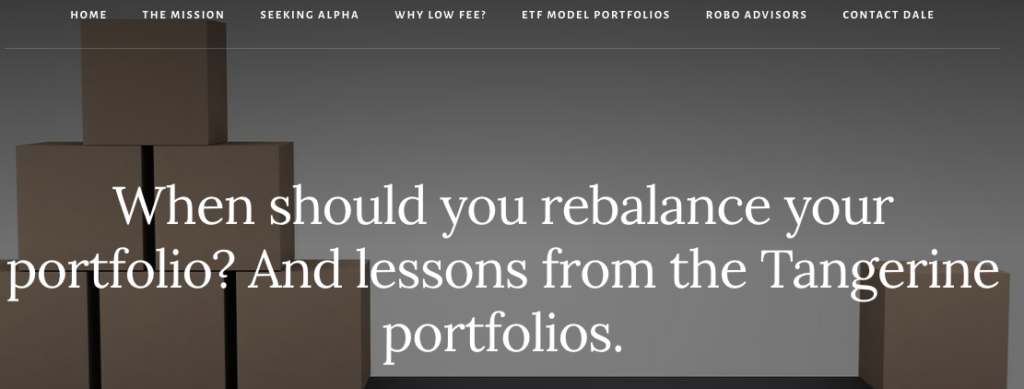By Dale Roberts, cutthecrapinvesting
Special to Financial Independence Hub
How often should you rebalance your portfolio? There’s good news on that front as less is more. We’ll take a look at a very telling chart from Frederick Vettese. And I take another look at the very telling perfomance table for the core Tangerine Portfolios. In this post I will also take you through my top observations of the week – by way of my Twitter / X Tweets. That includes – bonds vs GICs, big dividends under attack, my U.S stock portfolio returns, and what’s in store for the Canadian banks.
Courtesy of Fred Vettese in the Globe and Mail, a look at rebalancing a core ETF portfolio.
Here’s the link for those who have a Globe subscription.

On April 1, 2013, $1,000 was invested in each of four exchange-traded funds: a U.S. stock ETF, denominated in Canadian dollars (stock symbol XUS), a Canadian stock ETF (XIC), an international stock ETF (XEF) and a Canadian bond ETF (XBB). The initial asset mix is therefore 75-per-cent equities and 25-per-cent bonds.
Fred’s test showed almost identical results for rebalancing every quarter and once a year. That suggests that you can save yourself some time and effort (and perhaps trading costs) by rebalancing just once a year.
We can also see that when the unbalanced portfolio performed better during a period of robust stock returns. That said, the portfolio risk level has increased.
I have been evaluating portfolios for many years (decades) and more often find that rebalancing once a year often leads to greater returns. It allows a successful asset to go on a greater run before the money is moved to the under performing asset.
You might also consider rebalancing based on thresholds – perhaps when an asset is 5% or more about your target allocation.
The lessons of the Tangerine Portfolios
I had another look at the index-based Tangerine Portfolios. As you may know I was an advisor and trainer with Tangerine for several years. Those are a wonderful solution for those who want lower-fee managed portfolios and investment advice.
You can also have a look at the Tangerine Global ETF Portfolios.
There are many lessons that can be learned or observed from the returns of the portfolio models. I offered some ideas in this Twitter thread.
While you can check out that thread, and yes you should follow me on Twitter / X I will strip out the main lessons (shown below).
Lesson 1: Risk and returns
Investors were rewarded for taking on more risk. The risk/reward proposition.
An all-equity portfolio might earn in the area of 9% annual, while a balanced growth model is more 7%’ish and a balanced model more 6%’ish. Keep in mind that the start dates for the balanced portfolios was terrible – just before the financial crisis in 2008.
Lesson 2: Too conservative?
Returns can be quite modest for Balanced Income (70% bonds) and Balanced (40% bonds) portfolios. We might need to take on more risk (more equities) to reach our goals. But we must invest within our risk tolerance level. Higher risk portfolios will offer greater volatility – steeper declines in recessions and market corrections.
Lesson 3: When we don’t invest
If your time horizon is less than 3 years, you should remain in cash. We see Balanced Income with a negative return at 3 years. Often, other models have extended periods of no positive return at 3 years. If your time horizon is 5 years, and given the generous yields today for GICs, cash and ultra short bonds, it may make sense to stay in these ‘risk free’ investments – compared to a Balanced Income or Balanced Portfolio.
More on portfolios and time horizons. 1-3 years: Cash / GICs / Ultra short bonds. 3-5 years: Balanced Income or Balanced. 5-7 years: Balanced Growth 10 years or more: Equity Growth Of course if your risk tolerance level only allows for a Balanced Portfolio, but your time horizon is very long, you still stick with the Balanced Portfolio. Your risk tolerance overrides time horizon.
Lesson 4: Market corrections and returns
Market corrections will greatly impair returns. For the three Balanced Portfolio models, the inception date returns include the Financial Crisis when stocks fell by 50%. We see some very modest returns from that start date. In fact, the bond-heavy portfolio outperformed the other portfolio models until June 2014. It took 6.5 years for the more stock-heavy portfolios to catch and pass the low-medium risk Balanced Income Portfolio.
My U.S. Portfolio on Twitter
Here are a few more bits covering what I was up to on Twitter recently. I will update our portfolios on Seeking Alpha and on Cut The Crap Investing. Here’s a look at my personal RRSP Portfolio – American style.
The defensive wall is Walmart, Pepsi and Johnson & Johnson.
The history of bonds
I find this fascinating. The history of bonds in the U.S. That charts suggests that we are at the top, if the mountain shape/period on the chart was a single outlier.
Of course, we don’t know with any certainty where bond yields go next.
Big dividends under attack
Check out my commentary in reply to Mark’s post on My Own Advisor.
For the record, I think there is incredible value in the big dividend space. I added to VDY this past week in a couple of accounts. But let’s certainly acknowledge the risks. As per my response Tweet, always keep greater diversification in mind.
Big banks to muddle through?
The big Canadian banks are likely to muddle through.
GICs vs bonds
That said, I am a big fan of the GICs on offer today – check out the GIC rates at EQ Bank.
Thanks for reading. Don’t forget to follow this blog. It’s free. Simply enter your email address in the Subscribe area on this post.
Dale Roberts is a former advertising writer and creative director and long time index investor. In 2013, he followed his passion to become an investment advisor, and then trainer at Tangerine Investments. He won Advisor of the Year in his first year. He left Tangerine in 2018 to start Cut The Crap Investing, where he helps investors learn how to use ETFs, simple stock portfolio models and Robo Advisors to full advantage in the accumulation stage, and especially in retirement. A ‘hyper-focuser’ Dale has spent thousands of hours studying retirement – from the financial planning aspects to the portfolio models that make it happen. Early in 2025 he co-founded Retirement Club for Canadians, described in this Findependence Hub blog. Keep in mind Dale is not a financial planner. Retirement Club provides ideas and learning for consideration. As we know, self-directed investors are responsible for their own investment decisions. This blog originally appeared on his site on Oct. 7, 2023 and is republished with permission.



